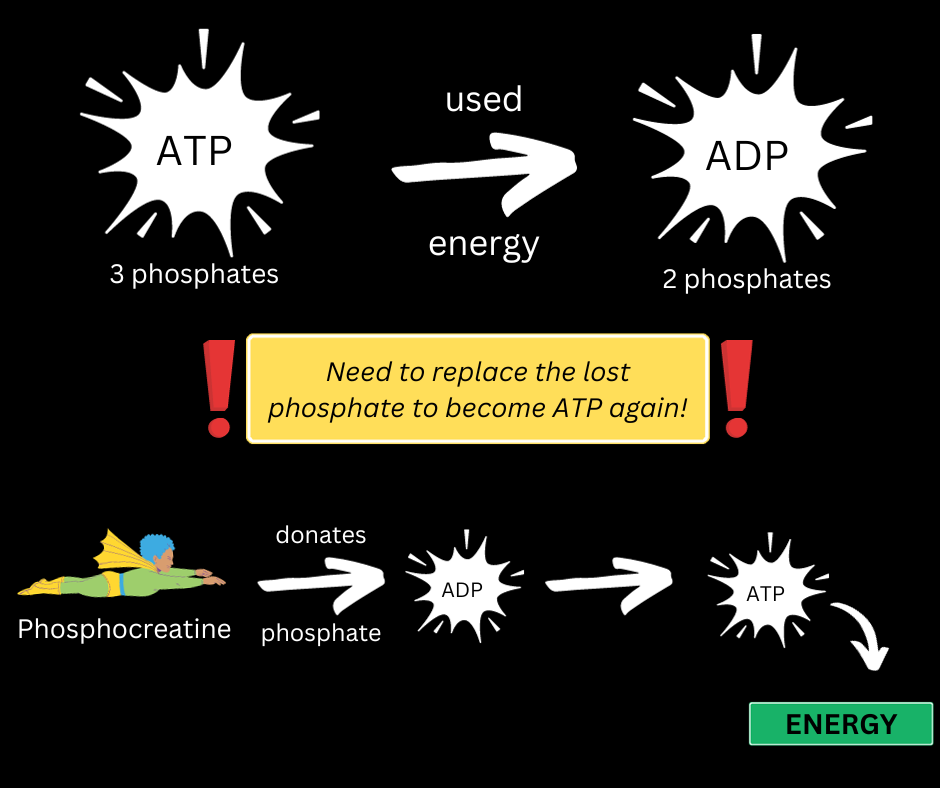While many supplements come and go as nothing more than a fad, creatine has been around since the 1800s and has been studied for physiology purposes for ~25 years. You might’ve heard of it in the context of strength-based sports, for those wanting to maximise muscle mass, but the relevance of creatine to endurance athletes (and even the general population) is greater than you might think.
What is creatine?
Creatine occurs naturally in food, like meat and fish, and your body also produces it in your liver, pancreas and kidneys. It’s stored in the muscles where it’s used to generate more adenosine triphosphate (ATP - aka energy).
Phosphocreatine, which is just a phosphate group attached to creatine, is also stored in your muscles. Using ATP for energy means a phosphate group is removed, leaving it as ADP.
D = di = 2 → diphosphate = 2 phosphates vs. the original ATP…
T = tri = 3 → triphosphate = 3 phosphates

Now it’s phosphocreatine’s time to shine. It graciously donates a phosphate group, so ADP can become ATP and generate more energy.
Intense exercise increases ATP demand up to 1000 times the normal rate. Having more creatine on hand to form phosphocreatine and subsequently turn ADP back into ATP means being able to generate energy for longer.
However, a muscle can only store so much creatine and phosphocreatine at once, so it’s not as if taking creatine will turn you superhuman with unlimited energy. But it can extend the time you're able to create ATP for.
Does creatine enhance your performance?
In the scientific literature, creatine has been studied for sport (among other areas), typically for short bursts and intermittent efforts. The research in endurance sport has been minimal, but a recent 2023 paper explores its usage in this area.
Though the results of time trial performances are mixed overall, the benefits may primarily exist in the end surges, like in the final stages of a race.
Time to exhaustion seems most favourably impacted during shorter bouts of high intensity exercise, though longer bouts can still be positively affected (just at a lower magnitude). The effect also looks promising when you’re working at near maximal intensity.
For endurance athletes, this would apply to finishing sprints, and the research does show a benefit in this area, including enhanced power output during intervals in triathletes, increased time to exhaustion in trained individuals, and peak power and improvement in final sprints in elite cyclists.
If you’re used to measuring your power output and critical power threshold, you might know that the amount of work you can perform above critical power is related to replenishing that phosphocreatine content, a notable feature of creatine that we mentioned earlier. But, the direct studies on this application are minimal and have – you guessed it – mixed results.
How creatine impacts your performance
Creatine’s strengths include increasing anaerobic work capacity and increasing time-to-exhaustion during high intensity exercise. It also boasts some other accolades, including an ability to encourage glycogen storage.
Lactate buffer As we discussed earlier, phosphocreatine separates to donate a phosphate group. When it does this, it also consumes a hydrogen ion. Subsequently, the acidity is reduced (one less hydrogen ion), creating a buffer. An incremental cycling test demonstrated this effect, as the creatine supplementation group had attenuated blood lactate responses at the end of each stage.
Muscular efficiency The mechanisms described in the review highlight creatine’s ability to favourably impact the ratio of power output to oxygen consumption. In other words, at a certain intensity, creatine supplementation could result in you needing to consume slightly less oxygen to maintain a given intensity.
This could improve your ventilatory threshold and VO₂ max. To note, study results are mixed, so we don’t know if this is an always, maybe, or simply a fluke. More importantly (and like so many other areas of sports nutrition), individual differences are often at play. Genetics, diet, and fibre-type distribution could all be variables that affect whether or not creatine supplementation makes a difference.
Recovery Creatine can also act as an antioxidant and anti-inflammatory, encouraging recovery and reducing inflammation markers following exercise (as seen in runners, elite endurance athletes, and young soccer players) when taken for 5-7 days prior to a big effort.
Does this mean you should take creatine after a hard workout? Not necessarily.
The most important element of creatine supplementation is consistency, since the goal is to saturate your stores. There might be a benefit for fat-free mass gains to take it after strength workouts (whilst still taking it every day), though the jury’s still out.
Creatine’s effect on weight and hydration
The bad rap creatine gets for causing weight gain is double-sided. While it can cause a small increase in body mass, this is due to water retention. So, similarly to glycogen, creatine is 'osmolytic' and pulls water into your muscle cells. The benefit of this is that it aids your hydration status.
Research shows creatine enhancing hydration status and improving thermoregulatory responses to exercise in the heat. For example, football players supplementing with creatine had less issues with cramp, dehydration and heat illness; a systematic review with meta-analyses similarly found creatine reduced risk of heat injury.
The most significant amount of weight gain is usually seen after a loading week (~1-2 kg), since it’s a rapid increase in saturation. However, the benefits of creatine may outweigh (pun absolutely intended) the mass change.
For example, a study that used a creatine loading phase and high carbohydrate intake in cyclists found significant power output improvement in closing sprints, but also no detrimental effect specifically from body mass on a performance test.
Is there an interaction between creatine and caffeine?
Cutting to the chase on this hot topic, caffeine does not necessarily interfere with the benefits of creatine.
But the research is varied and we need more specific studies before coming to a solid conclusion. The early studies on combining creatine and caffeine expected to see a boost in the performance-enhancing effects, since both are considered to be ergogenic aids. The results were, infact, the opposite, suggesting caffeine blocked the benefits. A follow-up study suggested this was due to the combo increasing muscle relaxation time, subsequently interfering with performance.
The kicker, though, is that several studies showed notable GI discomfort in the creatine-plus-caffeine groups, suggesting a possible explanation for the lack of performance improvement.
There are a couple of other theories on the real culprit for the caffeine and creatine studies showing a lack of ergogenic aids. From a practical standpoint, it’s okay to not pick one or the other and instead keep an eye on GI symptoms, especially if you follow loading phases.
Additionally, you could consume creatine and caffeine at different times throughout the day. (Personally, this is the approach I take, and have been “successful” with it so far. 🤷🏻♀️)
Creatine outside of sport
Let’s say creatine never actually helps you squeeze past your opponent in a race-defining final sprint. Was it all for nothing? Maybe not.
As I mentioned earlier, creatine has been researched for other applications outside of sport. One such area is the brain, as supplementation may increase creatine and phosphocreatine storage here by up to 10%.
Conceptually, it makes sense to have saturated stores in your brain, as we know it’s helpful in generating ATP and the brain definitely handles a large workload. Cognitive tasks elevate brain activity, and acute stressors (including sleep deprivation, hypoxia, fatigue) further elevate the need for ATP to meet demands.
Research has shown improvements in short-term memory, intelligence and reasoning tests with creatine supplementation, and there’s promising evidence for long-term memory and even diseases, like Alzheimer’s and Parkinson’s.
It also might reduce traumatic brain injury severity and improve recovery, explaining its suggested usage in high contact sports, such as American football and fighting.
Creatine appears to make a bigger difference for vegetarians compared to meat eaters (the latter tend to have higher starting creatine stores due to meat consumption), as well as for older individuals.
How to use creatine
If you want to do a loading phase to saturate your stores, take 20-25 grams per day for 4-7 days, split into 4-5 doses.
Though the benefit of a loading phase is maximising results sooner, it doesn’t translate into better results over the long term. You’re also risking GI discomfort, as this is observed in loading phases for some individuals.
Alternatively, maintenance doses of ~3-5 grams of creatine daily can still saturate your stores after several weeks of supplementation (just a more gradual increase in performance benefits).
Cycling creatine on and off is unnecessary, contrary to the previous belief that creatine usage can downregulate endogenous creatine production over time. The research doesn’t show any evidence for this after creatine supplementation ceases. And since keeping stores saturated is the primary goal, cycling on and off doesn’t appear helpful.
There are many other forms of creatine on the market, but creatine monohydrate is the OG (as well as the most researched). There’s no evidence for any other forms being better. Luckily, creatine monohydrate is typically the cheapest anyway, so it’s a double win.
In a nutshell...
Though it’s not entirely clear-cut, there is a reasonable amount of evidence that creatine supplementation might be useful to endurance athletes - specifically those who compete in events demanding short bursts of power or sprints rather than long, evenly paced time trials.
Instead of being a complete "game-changer", creatine would likely fall into the ‘marginal gains’ category of performance enhancement.
